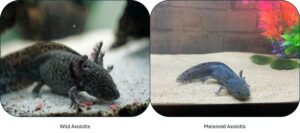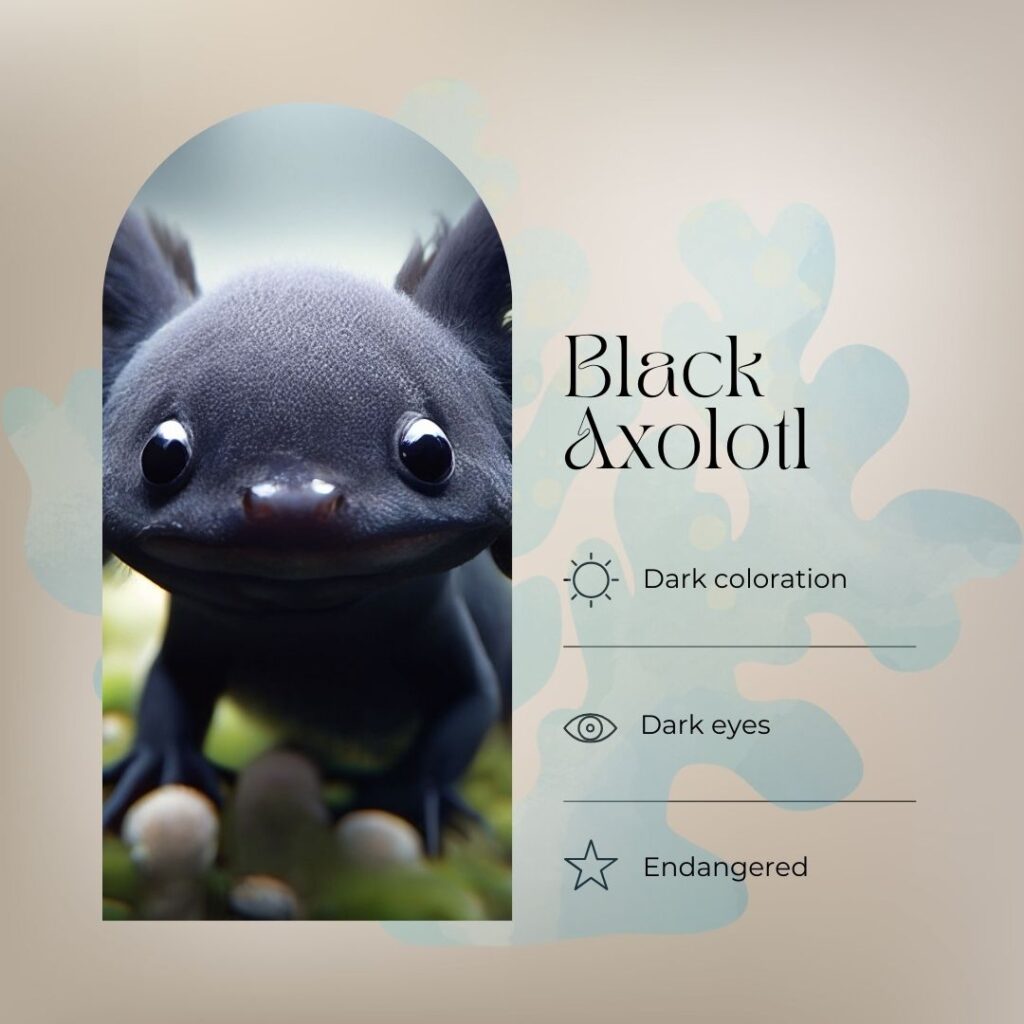The axolotl is a remarkable and fascinating amphibian, which are renowned for its extraordinary regenerative capabilities (Seifret et al., 2012). These amphibians are native to the lakes near Mexico City, they can regrow limbs and organs which have intrigued both scientists and pet lovers. Among various color variations of axolotls, the mysterious black axolotl is particularly the melanoid variety, which is notable for its deep and striking appearance. This post delves into the characteristics, care needs, and charm of these stunning creatures.
What is a Black Axolotl?
The mysterious black axolotls commonly known as “melanoid” axolotls are a rare morph that is characterized by the absence of iridophores and xanthophores (Kabangu et al., 2023), the pigment cells that are responsible for shiny and yellow hues in the other varieties of axolotl. This lack of pigments gives melanoid axolotls their matte black appearance, with a consistent dark color throughout their bodies, including their belly, which distinguishes them from other varieties. Their dark eyes enhance their mystique, creating an intense and captivating look.

Although these amphibians typically exhibit a deep, dark black coloration, it can occasionally vary slightly from very dark brown to charcoal gray. This uniform coloring is a key feature that sets them apart from the wild-type axolotls, which have a dark back and a lighter underside. Melanoid axolotls are often mistaken for those with a wild axolotl color, but they are different in several ways. They have more pigment in their skin than the wild type, giving their bodies a dark brown or black color. These solid-colored axolotls have black gills and eyes. As the melanoids mature, they retain this consistent black appearance, unlike some other morphs that may lighten as they age.
Caring for a Black Axolotl
The care involved for mysterious black axolotls is similar to the care for any other axolotl variety. These intriguing creatures thrive in a cool, clean, and stable environment, which is essential for their health and well-being. The key factors to consider when providing care for black axolotls include:
Water Temperature:
Axolotls thrive in cooler water, with an ideal temperature range of 60-64°F (16-18°C) (Blooi et al., 2015). When the water temperature exceeds this range, it can lead to stress and introduce various health problems for these delicate amphibians. It’s crucial to maintain the appropriate water temperature.
Using a high-quality aquarium chiller is an effective solution for temperature regulation, especially if you live in a warmer place. Alternatively, placing the tank in a naturally cooler area of your home can also help maintain the desired conditions. Regularly monitoring the water temperature with a reliable thermometer will further ensure that your axolotl remains comfortable and healthy.
Tank Setup:
The aquarium should provide adequate space for the axolotl to move around comfortably, with a minimum recommendation of a 20-gallon (75-liter) (Mallapur et al., 2005). This size ensures that your axolotls have enough room to swim, explore, and express natural behavior without feeling confined.
Lighter-colored substrates enhance the visibility of dark melanoid axolotls in tanks. This contrast not only allows you to easily spot your melanoid but also creates a visually appealing environment. Consider using sand, light gravel, or pale decorations to create a vibrant habitat that highlights the astonishing beauty of your black axolotl while promoting a stimulating environment for exploration.
Water Quality:
Axolotls are particularly sensitive to water quality, making it crucial to maintain an appropriate pH level of 6.5 to 7.5 (Horne et al., 1995). Regular water changes are essential to keep the environment clean and free from harmful toxins. Low pH levels can lead to increased mortality and reduced growth rates in amphibians, including axolotls. For instance, studies show that acidic conditions (pH below 5.6) can be lethal to various amphibian species, indicating a similar risk for axolotls (Freda et al., 1986).
Additionally, it’s important to use a filter that creates minimal current, as axolotls do not thrive well in strong water currents and may become stressed. A gentle filter helps to maintain water clarity without disturbing the axolotl’s natural behavior.
In order to ensure a healthy habitat, water must be regularly tested for ammonia, nitrite, and nitrate levels. Monitoring these parameters helps identify issues early and maintain a safe environment. Implementing these practices will contribute to the overall health and well-being of your aquatic companion.
Axolotl Diet:
Ambystoma mexicanum aka black axolotls are carnivorous and flourish on a diet that is rich in protein (Lévesque et al., 2010). A high-protein diet supports their unique regenerative abilities and limb regeneration. Ideal food options include earthworms, bloodworms, brine shrimp, and specially formulated axolotl pellets. Provide appropriately sized food for melanoids; larger pieces can hinder digestion. Axolotls exhibit opportunistic feeding habits, often consuming prey that is readily available in their environment (Rost et al., 2016).
Lighting and Hiding Spots:
These amphibians are nocturnal, so they don’t need intense lighting. As a fact, dim lighting is preferable, particularly for black axolotls, as bright light could induce stress. To create a comfortable environment, providing plenty of hiding spots, such as caves, logs, or artificial plants, to replicate their natural habitat and help reduce stress.
Breeding and Genetics
The genes of melanoid axolotls are recessive, meaning that both parents must carry the genes for the trait to be expressed in their offspring (Frost & Malacinski, 1979). Black axolotls are rarer, prompting careful breeding to maintain genetics. Melanoid axolotls can sometimes be mistaken for other darker morphs, such as wild-type or melanistic axolotls. However, their unique genetic markup and absence of iridescent pigments (iridophores and xanthophores) distinguish them.
Axolotls breed readily in captivity, with females that are capable of laying hundreds of eggs at once. However, raising axolotl larvae is quite challenging, as they require live food, such as brine shrimps or microworms, along with carefully monitored water conditions as discussed above to thrive.
Fascination with the Black Axolotl
One of the most captivating features of the black axolotl is its appearance. Their dark, sleek body gives black axolotls unique charm, distinguishing them. The absence of shiny pigments creates a matte black finish, offering a subtle elegance that appeals to pet owners drawn to these unique and rare amphibians.
Compared to leucistic and golden albino, melanoid axolotls seem less striking. However, those who appreciate the beauty of these creatures often find that the understated nature of their appearance, combined with their dark eyes and calm demeanor, makes them specifically fascinating.
The Importance of Conservation
Despite their popularity as pets, wild axolotls are critically endangered due to their habitat loss and exceeding pollution in Mexico. Conservation efforts protect wild populations, while captive breeding programs in the pet trade sustain the species in captivity.
If you are considering an axolotl as a pet, make sure to source it from reputable breeders who prioritize the animals’ health. Keep in mind that axolotls can live up to 15 years with proper care, making them a long-term commitment.
Conclusion
Black axolotls, melanoid axolotls, or Ambystoma mexicanum are a captivating variety of this already intriguing species. Their matte dark color and lack of shiny pigments create elegance. While they require care similar to other varieties, their striking look makes them a favorite among amphibian enthusiasts.
Melanoid axolotls are a rewarding addition to any aquarium, appealing to unique creature enthusiasts. Provide a suitable environment, a healthy diet, and proper care to ensure these beautiful animals thrive for years
Thanks for reading, for more interesting articles please visit our homepage.



